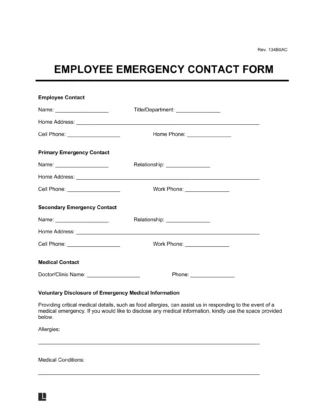
Document the emergency contact details of an employee.

Updated March 25, 2024
Written by Sara Hostelley | Reviewed by Brooke Davis
An employee emergency contact form is a document that includes the names and contact information of two or more of an employee’s closest friends, family members, or other loved ones.
The employer should collect the completed form from the employee, record it, and reference it if the employee is in an accident or sustains an injury while working.
Here’s how having emergency contact details on file can help you as an employer:
To Provide Immediate Assistance: In a workplace accident, employers can notify emergency contacts to assist injured employees, including seeking medical help or making legal medical decisions (if authorized).
To Communicate with Family Members in a Crisis: Employers can effectively communicate with employees’ designated contacts during critical situations, such as security incidents or natural disasters, to provide updates and reassurance.
To Meet Compliance Requirements: Depending on the nature of the employee’s work, some employers demand employees to fill out emergency contact forms to comply with their jurisdiction’s or regulatory body’s requirements.
To Promote Employee Safety and Morale: Employers prove their commitment to employee safety and well-being by maintaining accurate emergency contact details. This proactiveness can foster a positive work environment and boost employee morale.
To Access Medical Information: If an employee has a medical emergency, their employer can refer to their emergency contact form to see if they listed any special conditions or instructions for handling an issue.
Here are some scenarios when it would be appropriate for an employer to notify an employee’s emergency contacts:
The employee should include their personal information at the top of the form. This way, their employer will easily know who the form belongs to.
Ask the employee to provide a primary emergency contact and a secondary individual. This way, you’ll have a backup option if the first person is unavailable.
The employee should provide the basic information about both contacts; such as relationship with the employee, phone numbers, and home address.
Request the employee to provide their preferred doctor or medical clinic. Leave a space for them to list the healthcare provider’s contact information so you can reach them if a medical issue arises.
It won’t always be possible to have the employee’s preferred healthcare provider tend to their needs in an emergency, but having their preference on file shows compassion and respect for their wishes.
Let the employee list their medical information, including known medical conditions or allergies. They can also include their medications, blood type, and specific medical instructions or preferences. Please clarify that this disclosure is voluntary and that the employee may opt-out.
The employee can provide their health insurance provider, policy number, and contact information for the insurance company if they wish to do so.
Allow the employee to list any other individuals you should contact if the primary and secondary contacts don’t respond. You may ask for the contact information of close friends, neighbors, or caregivers.
Have the employee fill in the name of their employer so they understand with whom they’re sharing their information. Designate lines for them to sign their name and date the form so they can confirm that the employer and its representatives have permission to contact the listed personnel.
Inform employees that they should select their emergency contacts based on the following factors:
Naturally, any spouse or parent makes an ideal emergency contact as they would likely respond quickly when necessary. A close friend or adult child can also be a good contact. Whoever the employee chooses, they should be people the employee knows and trusts well.
Once the employee names their contacts, they must alert the contact so they know that the employer might contact them if an emergency occurs.
Download an employee emergency contact form template in PDF or Word format: